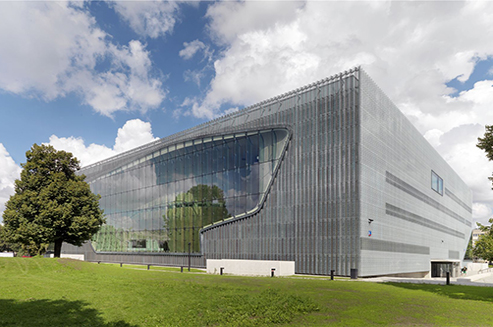Polin Museum of the History of Polish Jews (POLIN Museum) is the first and only museum dedicated to maintaining the memory of the civilisation created by Polish Jews in the course of a millennium. As a museum of life, it engages with the present and opens out to the future. As an educational and cultural institution, the museum is dedicated to stimulating dialogue in the spirit of mutual understanding and respect.
Polin Museum was founded in a symbolic place in the centre of Warsaw: Muranów – the area of the pre-war district inhabited mainly by Jews which, during the Second World War, was transformed by the Germans into a ghetto. The museum completes the history of the place: the nearby Monument to the Ghetto Heroes commemorates the Polish Jews who died, and the museum is a reminder of how they lived.
While the chasm created by the Holocaust can never be repaired, the exhibition and the programmes it inspires can build bridges across the rupture. Those bridges could reconnect Jews abroad to their own histories in Europe. They could reconnect people living in Poland today to the Jewish past of their own towns and cities – and to those who descend from the Jews who once lived there.
The museum building was designed by the Finnish studio Architects Lahdelma & Mahlamäki, who won the international architectural competition for the design of the museum building in 2005. Chief architect of the building was Professor Rainer Mahlamäki. Construction works took from June 2009 to March 2013.
The core exhibition is a journey through the 1,000-year history of Polish Jews – from the Middle Ages until today. Visitors can discover how Jews first arrived in Polish lands, why they stayed, and how Poland became home to one of the largest Jewish communities in the world – there were 3.3 million Jews in Poland before the Holocaust. Visitors will find answers to questions such as: how did Jews come to Poland? How did Poland become the centre of the Jewish Diaspora and the home of the largest Jewish community in the world? How did it cease to be one, and how is Jewish life being revived?
The core exhibition is made up of eight galleries, spread over an area of 4,000 sq.m., presenting the heritage and culture of Polish Jews, which still remains a source of inspiration for Poland and for the world. The galleries portray successive phases of history, beginning with legends of arrival, the beginnings of Jewish settlement in Poland and the development of Jewish culture.
The galleries’ names and time periods covered are:
Forest (a legend about the origins of the Jewish presence in Poland),
First Encounters (960–1500),
Paradisus Iudaeorum (1569–1648),
The Jewish Town (1648–1772),
Encounters with Modernity (1772–1914),
On the Jewish Street (1918–1939),
Holocaust (1939–1945),
Postwar Years (1944-to the present).
The exhibition shows the social, religious and political diversity of Polish Jews, highlighting dramatic events from the past, the Holocaust, and concluding with contemporary times.
It presents 1,000 years of Polish-Jewish coexistence, speaking of cooperation, rivalry and conflicts, autonomy, integration and assimilation. While seeking to confront thorny issues, the exhibition also bring attention to bright chapters in our common history.
The core exhibition is a narrative: visitors will be drawn into a story told by artefacts, paintings, interactive installations, reconstructions and models, video projections, sounds and words. The focus is on life; therefore, at each stage of the journey, it strives to remain close to life by letting people speak – Jewish merchants, scholars or artists from a given era, rabbis, housewives, politicians, chroniclers and revolutionaries. It gives the floor to those who perished and to those who survived.
The core exhibition was open on October 28, 2014. It is being developed by a team of international scholars and curators under the direction of Professor Barbara Kirshenblatt-Gimblett. The design was created by Event Communications, a London-based company, and by Nizio Design International from Warsaw. Thanks to these teams, the core exhibition employs reliable methods as well as cutting-edge multimedia solutions.
The design and creation of the core exhibition is financed and overseen by the Association of the Jewish Historical Institute of Poland, thanks to the support of donors from all over the world.
Polin Museum of the History of Polish Jews is a public institution of culture. It is the first public-private partnership institution of its kind in Poland created by the Ministry of Culture, City of Warsaw and the Association of the Jewish Historical Institute of Poland. Under the founding act, the public party provided $60 million (PLN 180 million) for the construction of the Museum building. They also cover the major part of the museum’s annual budget. The Association initiated the museum project and was responsible for the development and production of the core exhibition. Thanks to the support of donors from all over the world, the Association raised $48 million (PLN 145 million) for this purpose.
Photo © Kryński/ Polin Museum of the History of Polish Jews


